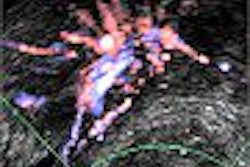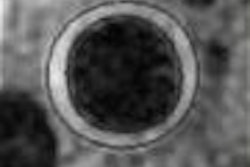ORLANDO, FL - Any future for therapeutic ultrasound as an adjunct to angioplasty may be years away, but early research on its potential is one of the featured presentations at this week's American College of Cardiology (ACC) meeting.
A new study by researchers at the University of California, San Diego (UCSD), reported that a therapeutic US device (from Timi 3 Systems Inc., founded by co-author Dr. Robert J. Siegel) improved perfusion to ischemic myocardium in eight canine hearts. The investigators used ultrasound -- specifically, myocardial contrast echocardiography -- to gauge the impact of the therapeutic US.
Another study led by Siegel, using laser Doppler measurements and surface pH for evaluation, previously found that ultrasound energy enhances blood flow in ischemic myocardium (Journal of the American College of Cardiology, October 6, 2004; Vol. 44:7, pp. 1454-1458).
"At the moment, the number of studies we've done is small, and the differences we've observed are in the range that we can't really conclude how much of an effect there is and how valuable it would be," said Dr. Anthony DeMaria, a senior author of the current study and past president of the ACC.
"But we see enough that further experiments are clearly warranted," DeMaria continued. "There's a signal in that data, that there seems to be a bit more perfusion that results from the ultrasound."
The UCSD investigators, led by Andrew Kahn, Ph.D., performed left lateral thoracotomies to expose the hearts, then occluded the left anterior descending arteries with a suture loop. The occlusions were left untreated for one hour; they were then treated with therapeutic ultrasound for a second hour before being removed.
Therapeutic US was provided by a prototype transducer with 29-kHz pulsed wave ultrasound with a maximum intensity of 1.4 W/cm2 administered using a 30% duty cycle.
Echocardiography was performed with an HDI 7500 (Philips Medical Systems, Andover, MA) with a 2-4 MHz transducer and color-coded harmonic power pulse inversion in the short-axis view, using Optison (Alliance Pharmaceutical, San Diego) for contrast.
"An increase in perfusion was observed in six of the eight animals studied, and the average post-treatment intensity was 1.4 dB (40%) greater than the pretreatment intensity," the researchers reported.
"I think if in a subsequent larger animal study, with more precise quantitative measurements, we found the same evidence that there was much-enhanced perfusion, then you'd be at the point where you could justify a clinical trial," DeMaria said.
"It's a simple device that could really expand the window for salvaging muscle," he said. "For a patient with an acute myocardial infarction, you'd put this device on almost immediately, perhaps even in an emergency vehicle, and that would facilitate perfusion of that myocardium until you got the patient to the cath lab and opened up the vessel."
The device might also be used after revascularization, DeMaria said, to facilitate reperfusion of the myocardium that is jeopardized but not irreversibly damaged.
But despite some promising results in animal models, there are no guarantees that such scenarios will become a reality in human healthcare -- as evidenced by the history of this particular therapeutic US device.
"This device underwent a clinical trial to dissolve thrombi in acute myocardial infarction, and the results indicated that it really was not additive to conventional reperfusion strategies," DeMaria noted.
By Tracie L. Thompson
AuntMinnie.com staff writer
March 7, 2005
Related Reading
Microbubbles plus ultrasound speeds thrombolysis in stroke, February 4, 2005
Transcranial ultrasound of little use as stroke therapy, January 24, 2005
Contrast-enhanced CT finds myocardial infarction, June 10, 2004
Time has arrived for contrast echocardiography, May 12, 2004
External therapeutic US accelerates thrombolysis in heart attack patients, December 9, 2003
Copyright © 2005 AuntMinnie.com



















